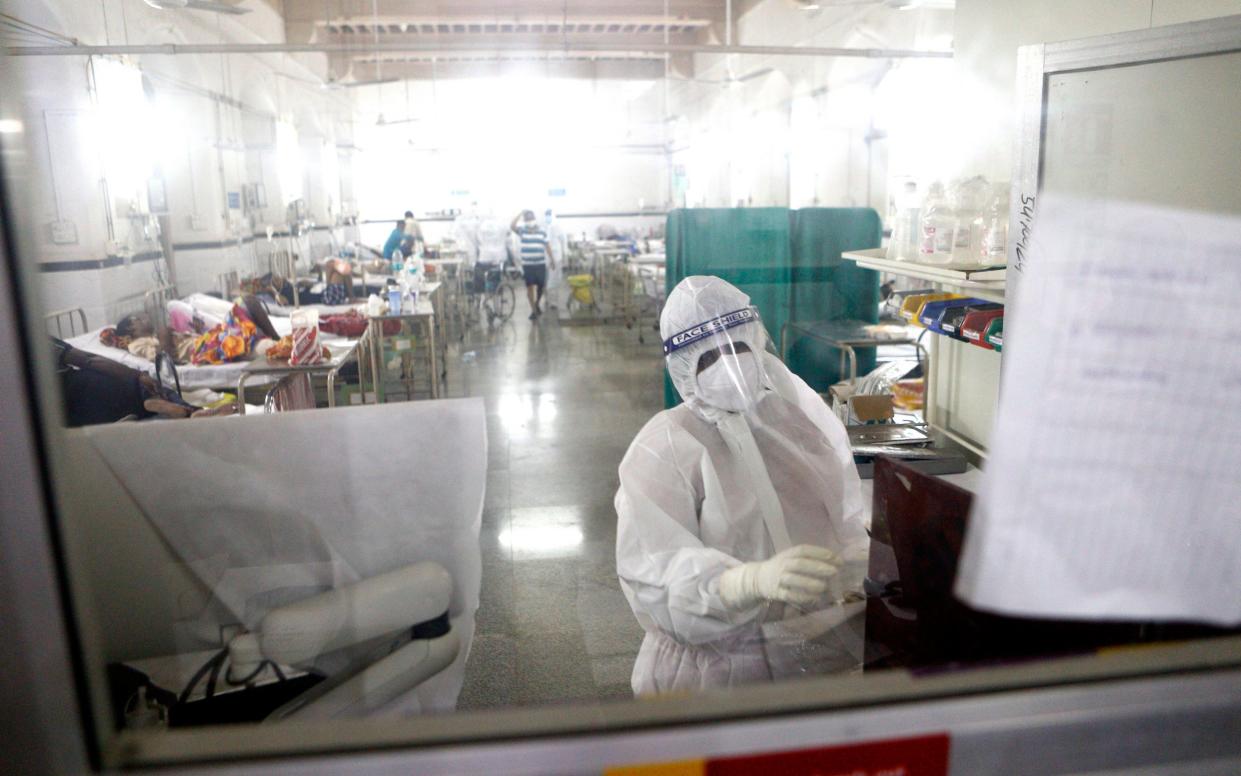India's hospitals face staffing crisis as omicron wave hits

Doctors across Mumbai have warned that already overwhelmed hospitals could run out of staff in a matter of weeks, as doctors contract the highly contagious omicron variant.
The Telegraph spent the day on the Covid wards at St George’s Hospital - one of the largest facilities in Mumbai - where 25 per cent of 650 resident doctors have contracted the virus.
Resident doctors are the backbone of the Indian health care system, carrying out the majority of day-to-day work, with many living on site.
“A lot of the doctors' symptoms are mild but I can’t send them back to their hostels as they live in close contact with other doctors there,” said Dr Akash Khobragade, the hospital superintendent.
“There has been a tremendous rise in patients and we are expecting that to continue considering the infectivity of omicron. Already we are understaffed and trying to cope with what we have available.”
India is already in the grips of a third wave of the virus. The number of new cases tripled in the week up to Sunday with infections doubling overnight in the city of Kolkata on Thursday.
The western state of Maharashtra, home to the densely populated city of Mumbai and the first entry point for many international travellers, has been the worst affected so far.

On Monday, the city reported over 8,000 new cases, compared to Delhi’s 4,099, with a test positivity rate of 17 per cent. As recently as December 25, Mumbai was reporting fewer than 800 cases.
Omicron, which is believed to be up to six times more contagious than the delta variant which overwhelmed India’s healthcare system last spring, is now spreading rapidly in the city’s high-rise flats and slum settlements.
At St George’s Hospital, a specialist Covid-19 facility, there were only seven people admitted with the virus one week ago. Now 117 out of the 320 available beds are occupied.
A similar pattern is emerging at other hospitals in Mumbai. Dr Mala Kaneria, an infectious disease specialist at Nair Hospital in the suburb of Byculla, described a “very explosive” increase in admissions since December 21.
“Cases are doubling everywhere and our staff are becoming Covid-19 positive. Not just doctors but also auxiliary staff. Omicron is definitely more contagious - with a greater R number - so each infected person is infecting a lot more people than we saw with other variants,” said Dr Kaneria.
At Lion Tarachand Bapa Hospital in the suburb of Sion West, at least six staff have tested positive. And at the CIDCO Covid Hospital in the suburb of Vashi, care was already being impacted by short staffing as doctors tested positive for Covid-19, according to Dr Sahil Moriwalla, the hospital’s consultant physician.
India has one of the world’s most underfunded public health systems and even before the pandemic had a shortage of 600,000 doctors and two million nurses, with rural areas worst hit.
The pandemic has only exacerbated staff shortages. At least 1,500 doctors died from Covid up to July 2021, according to the Indian Medical Association, and thousands more have quit the profession or left to work overseas.
India’s omicron staffing woes are shared by health systems around the world: in the UK one in five ambulance staff are currently off work, largely due to Covid-19, while in the United States, 1,000 hospitals are facing critical shortages of staff.
Back at St George’s Hospital, Covid patients lie motionless in their beds or wander round the wards in an attempt to pick up their strength again.
Manasvi Kolambekar, the duty nurse, suddenly switches on a speaker system, which plays a fast-tempo Hindi dance number into the ward, to cheer up the patients.
“We’ve had two staff members on this ward test positive and already we are having to work overtime to cover their duties. And this wave is just beginning,” said Ms Prashand.
“The last two years have been so physically draining. We’d faint in our PPE when it got hot and it’s so emotionally exhausting watching patients die and being away from our families.”
One positive so far is that the majority of Covid patients at St George’s have not been critically ill, with patients typically suffering fever, body aches, sore throats and headaches.
Patients are admitted when they have low blood oxygen levels or other conditions that make them more susceptible to the virus but the majority are being discharged after four or five days, says Ms Prashand.
Only nine patients out of 117 need treatment in an ICU or are on a heavy-flow ventilator.
Doctors at St George’s say another major difference with omicron is the speed at which patients are developing symptoms, typically two or three days after exposure to the virus. They are also seeing whole families or office blocks testing positive at once.
The fear in India is that if cases continue to double every few days the number of serious infections will rise, as staffing numbers plummet.
Mirroring data from South Africa, where omicron was first identified, St George’s is also seeing the greatest number of admissions among young people, with those aged between 21 and 30 making up about a third of patients.
Doctors say there are already scenes of panic among the families of those affected as memories of the country’s brutal second wave - when patients died in the street, waiting to be admitted to hospital - are still fresh.
Emotional family members clamour with doctors to admit their loved ones, even if they are currently asymptomatic.
“We cannot predict what will happen over the next few weeks but considering this last week and the number of patients it is concerning,” said Dr Khobragade.
“Just how many will need hospitalisation and oxygen supplies, that will be the key parameter. Meanwhile, a lot of our staff are going to be out of action.”
Protect yourself and your family by learning more about Global Health Security

 Yahoo News
Yahoo News 
